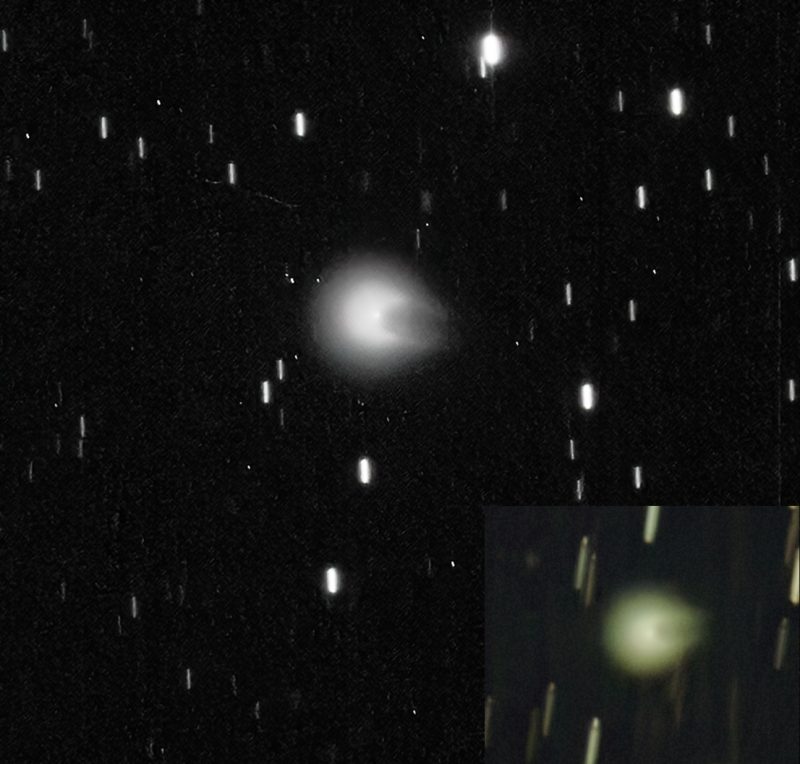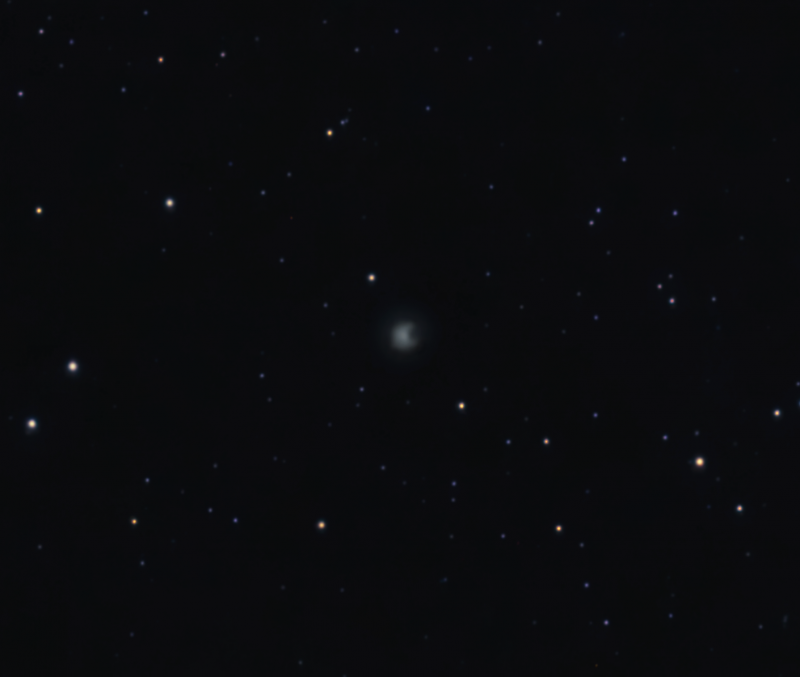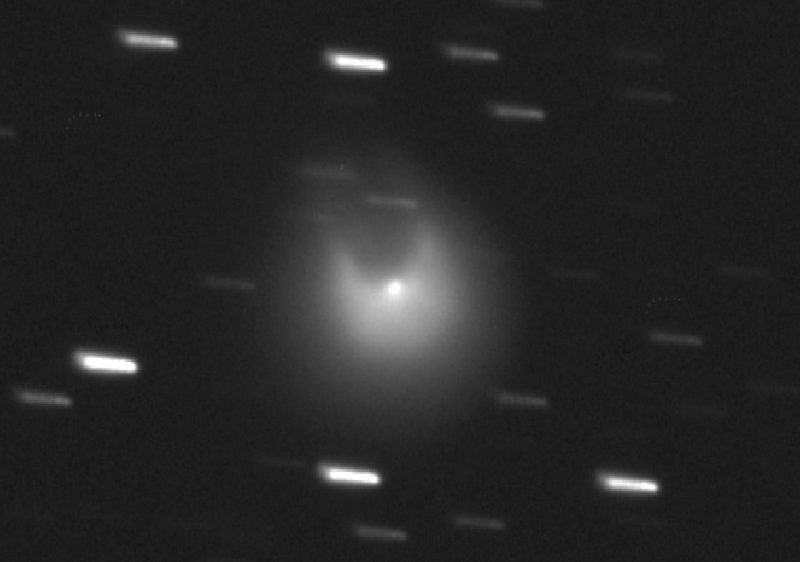
Comet Pons-Brooks had an outburst
Comet 12/P Pons-Brooks isn’t new to the inner solar system. It’s what’s called a periodic comet, in a known orbit around the sun, sweeping past us every so often, in this case every 71 years. And its next sweep past our home star will be in April 2024. But it’s already started putting on a show.
On July 20, 2023, the comet had what’s called an outburst, suddenly brightening by about 6 magnitudes. That’s a lot! Yet Comet 12/P Pons-Brooks still isn’t bright enough to see with the eye, or even binoculars … yet. It’s still only in the range of large telescopes. Still, as one of the brightest periodic comets, it could reach binocular range by March.
The comet was around magnitude 16 (beyond the reach of most backyard telescopes) before rapidly brightening to magnitude 11 (a nice object for small- to medium-sized telescopes) on July 20. The outburst gave the comet a peculiar “horned” appearance, or resembling the Millennium Falcon of Star Wars. Woo hoo!
As you can see from the images on this page by EarthSky community photographers, the comet is showing a distinct C or hooked shape.
Pons-Brooks in history
As mentioned, we’ve seen this comet in the past. Jean-Louis Pons and William Robert Brooks both spotted it in the 1800s. The comet now bears the names of those two sky observers.
And even before that, Chinese astronomers observed it as far back as the 1300s.
It comes near the sun every 71 years.
Sharing the sky with a total solar eclipse
And what we’ve seen so far in 2023 is just the beginning for this comet. Don’t forget, the total solar eclipse next year is on April 8, 2024. That means the darkened sun and comet will share the sky. The eclipse is about two weeks before the comet’s perihelion (closest point to the sun) on April 21, 2024.
So should you look for this comet during the April 2024 eclipse? It depends on how experienced you are at observing the sun. Even with the sun’s light mostly blotted out by the moon during the eclipse, you’ll likely still need optical aid to see the comet. Then … there’s the risk of blindness. Scanning with optical aid near the sun – even during an eclipse, when the sun is only momentarily darkened – is a pursuit best left to experienced observers.
Just be aware the comet is up there. But you might just want to leave it to the astrophotography experts to capture an image of the comet near the eclipsed sun on April 8, 2024.
Where is Comet Pons-Brooks now?
Comet Pons-Brooks currently lies just under four astronomical units (AU or Earth-sun distances) from the sun. At its closest point to the sun next year, the comet will be about 0.7 AU from our home star on April 21. Then it swings closest to Earth on June 2, when it’s 1.5 AU away from us.
According to TheSkyLive.com, the comet currently appears to be sailing among the stars of Draco the Dragon from our earthly point of view. But even though it recently became 100 times brighter, it’s not something observers can easily see quite yet.

How to see the comet
If you have a large telescope, you can try spotting the comet now from the Northern Hemisphere. Otherwise, you can wait for it to get closer and brighter. And, you might even see the comet during the total solar eclipse on April 8, 2024!
In August 2023, the comet will be hanging out in the head of the Dragon, quite close to the star Rastaban. The following few months it will be in Hercules, passing close to globular cluster M92 on October 13, 2023. (Astrophotographers, take note!) In early December, Comet Pons-Brooks will pass close to Vega in Lyra.
At the beginning of 2024, Pons-Brooks will glide through Cygnus the Swan. In February it will pass through Lacerta and on to Andromeda.
Comet Pons-Brooks in March and early April
In March, as it gets closer to the sun, the comet really speeds up and brightens. It will fly through Andromeda into Pisces and brighten toward the edge of unaided-eye visibility. And by April, the month of the eclipse and perihelion, Comet Pons-Brooks will be in Aries. Of course, the closer the comet gets to the sun, the harder it will be to see as it enters a twilight sky.
The sun will be in Pisces during the total solar eclipse on April 8, 2024. Jupiter is in neighboring Aries along with the comet. Remember, if you try to see the comet during the eclipse in binoculars, don’t look at the sun. You only have a few minutes of darkness to find it, so you may be better of just enjoying the spectacle of the eclipse with your eyes alone.
The comet’s closest approach to the sun and Earth
Comet Pons-Brooks will be in the vicinity of Jupiter from April 12-14. The comet’s closest approach to the sun (perihelion) is on April 21 in the constellation Taurus. As the comet moves away from the sun, it will soon drop out of sight from the Northern Hemisphere. But the Southern Hemisphere will be able to see the comet head toward Orion. It will be near Rigel on May 19 and 20.
On June 2, 2024, when the comet is closest to Earth, it will be dimmer because it’s farther from the sun. But you should still be able pick it up in binoculars. On that date, the comet will be in Lepus the Hare.
Then Comet Pons-Brooks will head back into the outer solar system, where it will remain until it returns in some 71 years’ time.
Photos of Comet Pons-Brooks
If you would like to share a photo you took of Comet Pons-Brooks, send it to us at our Community Photos page.

Bottom line: Comet Pons-Brooks underwent an outburst recently, rapidly brightening and taking on a peculiar shape. This same comet will share the sky with the eclipsed sun next April.
The post Comet Pons-Brooks: A comet to watch! first appeared on EarthSky.
from EarthSky https://ift.tt/T9R2a45

Comet Pons-Brooks had an outburst
Comet 12/P Pons-Brooks isn’t new to the inner solar system. It’s what’s called a periodic comet, in a known orbit around the sun, sweeping past us every so often, in this case every 71 years. And its next sweep past our home star will be in April 2024. But it’s already started putting on a show.
On July 20, 2023, the comet had what’s called an outburst, suddenly brightening by about 6 magnitudes. That’s a lot! Yet Comet 12/P Pons-Brooks still isn’t bright enough to see with the eye, or even binoculars … yet. It’s still only in the range of large telescopes. Still, as one of the brightest periodic comets, it could reach binocular range by March.
The comet was around magnitude 16 (beyond the reach of most backyard telescopes) before rapidly brightening to magnitude 11 (a nice object for small- to medium-sized telescopes) on July 20. The outburst gave the comet a peculiar “horned” appearance, or resembling the Millennium Falcon of Star Wars. Woo hoo!
As you can see from the images on this page by EarthSky community photographers, the comet is showing a distinct C or hooked shape.
Pons-Brooks in history
As mentioned, we’ve seen this comet in the past. Jean-Louis Pons and William Robert Brooks both spotted it in the 1800s. The comet now bears the names of those two sky observers.
And even before that, Chinese astronomers observed it as far back as the 1300s.
It comes near the sun every 71 years.
Sharing the sky with a total solar eclipse
And what we’ve seen so far in 2023 is just the beginning for this comet. Don’t forget, the total solar eclipse next year is on April 8, 2024. That means the darkened sun and comet will share the sky. The eclipse is about two weeks before the comet’s perihelion (closest point to the sun) on April 21, 2024.
So should you look for this comet during the April 2024 eclipse? It depends on how experienced you are at observing the sun. Even with the sun’s light mostly blotted out by the moon during the eclipse, you’ll likely still need optical aid to see the comet. Then … there’s the risk of blindness. Scanning with optical aid near the sun – even during an eclipse, when the sun is only momentarily darkened – is a pursuit best left to experienced observers.
Just be aware the comet is up there. But you might just want to leave it to the astrophotography experts to capture an image of the comet near the eclipsed sun on April 8, 2024.
Where is Comet Pons-Brooks now?
Comet Pons-Brooks currently lies just under four astronomical units (AU or Earth-sun distances) from the sun. At its closest point to the sun next year, the comet will be about 0.7 AU from our home star on April 21. Then it swings closest to Earth on June 2, when it’s 1.5 AU away from us.
According to TheSkyLive.com, the comet currently appears to be sailing among the stars of Draco the Dragon from our earthly point of view. But even though it recently became 100 times brighter, it’s not something observers can easily see quite yet.

How to see the comet
If you have a large telescope, you can try spotting the comet now from the Northern Hemisphere. Otherwise, you can wait for it to get closer and brighter. And, you might even see the comet during the total solar eclipse on April 8, 2024!
In August 2023, the comet will be hanging out in the head of the Dragon, quite close to the star Rastaban. The following few months it will be in Hercules, passing close to globular cluster M92 on October 13, 2023. (Astrophotographers, take note!) In early December, Comet Pons-Brooks will pass close to Vega in Lyra.
At the beginning of 2024, Pons-Brooks will glide through Cygnus the Swan. In February it will pass through Lacerta and on to Andromeda.
Comet Pons-Brooks in March and early April
In March, as it gets closer to the sun, the comet really speeds up and brightens. It will fly through Andromeda into Pisces and brighten toward the edge of unaided-eye visibility. And by April, the month of the eclipse and perihelion, Comet Pons-Brooks will be in Aries. Of course, the closer the comet gets to the sun, the harder it will be to see as it enters a twilight sky.
The sun will be in Pisces during the total solar eclipse on April 8, 2024. Jupiter is in neighboring Aries along with the comet. Remember, if you try to see the comet during the eclipse in binoculars, don’t look at the sun. You only have a few minutes of darkness to find it, so you may be better of just enjoying the spectacle of the eclipse with your eyes alone.
The comet’s closest approach to the sun and Earth
Comet Pons-Brooks will be in the vicinity of Jupiter from April 12-14. The comet’s closest approach to the sun (perihelion) is on April 21 in the constellation Taurus. As the comet moves away from the sun, it will soon drop out of sight from the Northern Hemisphere. But the Southern Hemisphere will be able to see the comet head toward Orion. It will be near Rigel on May 19 and 20.
On June 2, 2024, when the comet is closest to Earth, it will be dimmer because it’s farther from the sun. But you should still be able pick it up in binoculars. On that date, the comet will be in Lepus the Hare.
Then Comet Pons-Brooks will head back into the outer solar system, where it will remain until it returns in some 71 years’ time.
Photos of Comet Pons-Brooks
If you would like to share a photo you took of Comet Pons-Brooks, send it to us at our Community Photos page.

Bottom line: Comet Pons-Brooks underwent an outburst recently, rapidly brightening and taking on a peculiar shape. This same comet will share the sky with the eclipsed sun next April.
The post Comet Pons-Brooks: A comet to watch! first appeared on EarthSky.
from EarthSky https://ift.tt/T9R2a45

Aucun commentaire:
Enregistrer un commentaire